Wednesday, November 30, 2005
Berlin, Germany

In the German capital Berlin you can find this entrance to the Berliner Dom, a building that was built in 1905. The German Emperor Wilhelm II ordered the built of this Cathedral, designed by Julius Raschdorff. 114 m long, 73 m wide and 116 m tall, it was much larger than any of the previous buildings on this site and was considered a Protestant counterweight to the St. Peter's Basilica in Rome. During the Second World War, the building was bombed by the Allies and severely damaged. A temporary roof was installed to protect what remained of the interior and in 1975 reconstruction started. The restoration of the interior was begun in 1984 and in 1993 the church reopened. During reconstruction, the original design was modified into a more simple form and less tall. Photo by
Iris Nelson.
posted by /T/ at
1:28 AM


Monday, November 28, 2005
Truro, MA
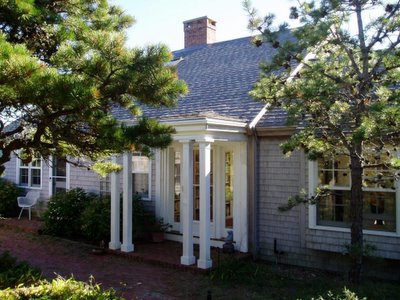
This photo that was taken in Truro, Massachusetts, was sent in by
Cynthia Stead. Truro is situated at Cape Cod and it has missed its chance at immortality when the little band of Pilgrims from the Mayflower decided not to stay in the rolling hills and moors that might have reminded some of them of home and to follow Captain Myles Standish to the area across the bay that became Plimouth. Although the Pilgrims didn't stay in Truro after a brief exploration that convinced many that they should, it was a find of seed corn, ten bushels, stored by the Pamet Indians on what is now known as Corn Hill, that helped to sustain them the following year. Settlers did not come back until two decades later, when the land now known as Pamet was part of a large tract granted to Thomas Prence and other proprietors of Nauset. In 1689 the Pamet Proprietors negotiated purchases of land from the Pamet Indians. In 1705 Pamet was established changed its name to Dangerfield. In 1709 Dangerfield separated from Eastham, incorporated as a town and changed its name to Truro.
posted by /T/ at
11:23 PM


Friday, November 25, 2005
Alenquer, Portugal

This front door to the St Francisco Convent in Alenquer was photographed by
Francisco Ourique. The convent was founded in 1222 by D.Sancha daughter of D.Sancho I of Portugal. The city of Alenquer was conquered by the moors in the XII century and had its first charter in the following century. The region around the town is famous for its wines, esp. the whites. It has two different delimitations but both confined to the municipality that gives name to it. The vineyards form great continuous spots, following the relief and developing along hillsides and valleys.
posted by /T/ at
1:05 AM


Thursday, November 24, 2005
London, England

This door leads you to the Royal Exchange in London. The Royal Exchange was founded in 1565 by Sir Thomas Gresham to act as a centre of commerce for the city. The design was inspired by a bourse Gresham had seen in Antwerp. The Royal Exchange was officially opened by Queen Elizabeth I who awarded the building its Royal title, on January 23, 1571. The Great Fire of London destroyed the original building in 1566 and the rebuilt echange got destroyed in a fire in 1838. The current structure was designed by Sir William Tite, and was opened by Queen Victoria on October 28, 1844, though trading did not commence until January 1, 1845. The Royal Exchange ceased to act as a centre of commerce in 1939, and is now a luxurious shopping centre. Photo by
Micelle Mitchell.
posted by /T/ at
12:05 AM


Monday, November 21, 2005
Bloomfield, CT
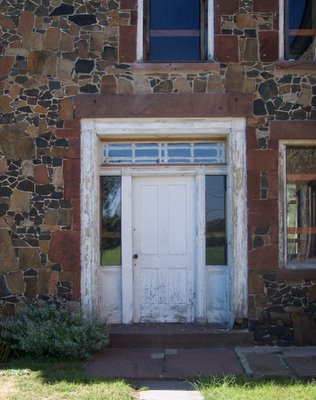
This door photographed by
Bill Owens is the entrance to the Capt. Oliver Filley House in Bloomfield Connecticut a.k.a. Wintonbury. The Captain Oliver Filley House, one of the more significant historic sites remaining in Bloomfield, was built in 1834, one year before the incorporation of the town. Captain Filley had the house, an unusual example of an all-stone Greek Revival with brownstone corbeling and lintels, built for his son Jay Filley. It is being restored through a partnership between the Wintonbury Historical Society and the Town of Bloomfield, and will be a museum, cultural center, research library, and office for the Wintonbury Historical Society.
posted by /T/ at
12:17 AM


Saturday, November 19, 2005
London, England
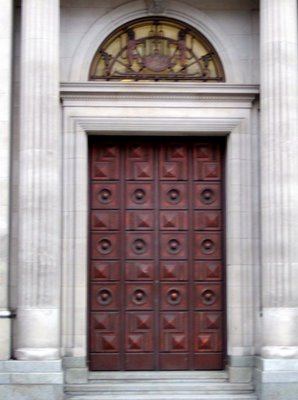
From
Micelle Mitchell comes this photo. It's taken around the underground station "Bank" in central London. This area of London is the home of the Royal Exchange that was founded by Sir Thomas Gresham in 1565. The Elizabethan merchant and courtier established the Exchange as a centre for commerce. At the centre of the original building was a vast courtyard where merchants and tradesmen did business. Queen Elizabeth I bestowed its Royal title and to this day the Royal Exchange is one of the sites from which new monarchs are announced.
posted by /T/ at
9:36 AM


Friday, November 18, 2005
New Haven, CT

This is one of the many entrances to the Yale University. Yale University was founded in 1701 as the Collegiate School in the home of Abraham Pierson, its first rector, in Killingworth, Connecticut. In 1716 the school moved to New Haven and, with the generous gift by Elihu Yale of nine bales of goods, 417 books, and a portrait and arms of King George I, was renamed Yale College in 1718. The photo was taken and sent in by
Bill Owens.
posted by /T/ at
12:23 AM


Wednesday, November 16, 2005
UlaanBaatar, Mongolia
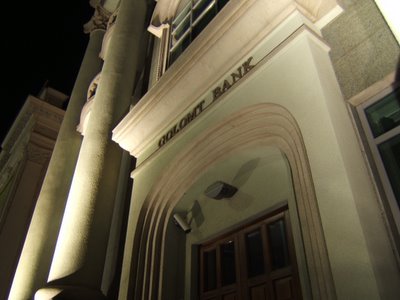
This is the entrance of the Golomt Bank in UlaanBaatar in Mongolia. Often called UB, Mongolia's sleepy capital has the look and feel of a neglected 1950s European city. The old Soviet cars are slowly being replaced by newer Japanese versions, but cows still wander the roads, and the traditionally dressed mingle on the streets with Mongolia's nouveaux riche. Built along the Tuul river and surrounded by lovely mountains, Ulaan Baatar is dominated by communist style highrise apartment buildings, but many locals also live in the extended outer suburbs. The centre of the city is Sükhbaatar Square. Foto by
Nick Tay.
posted by /T/ at
11:27 PM


Tuesday, November 15, 2005
Monsaraz, Portugal

The town that has been represented pretty much every month on this blog is Monsaraz in Portugal. As winner of the first Front Door of the month
António Caeiro has been providing all of the pictures from that beautiful place. This one is again a beautiful entry. So once again Thanks António, without your contributions this blog would not have been the same.
posted by /T/ at
4:04 AM


Sunday, November 13, 2005
North Bennington, VT
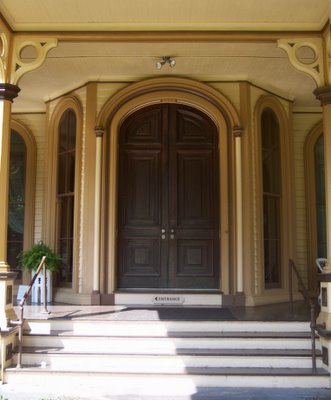
This is the front door but, as you can see in the photo by
Bill Owens, not the entrance to the Park-McCullough House in North Bennington, VT. The Park-McCullough House is one of the finest, most significant, and best Preserved Victorian Mansions in New England. Built in 1864-65 by attorney and entrepreneur Trenor Park (1823-1882), the house was designed by Henry Dudley, a prolific New York architect of the popular firm of Diaper and Dudley. It is an important example of a country house in the Second Empire Style and incorporates architectural features of the Romantic Revival style that were popular at the time. The house retains to a great extent the integrity and impact of its original design.
posted by /T/ at
10:18 PM


Friday, November 11, 2005
Chicago, IL

This door sent in by Sherry aka
YellowRose is the Front Door of the Tribune Tower on Michigan Avenue, Chicago, Ill. The design was the result of an international competition for "the most beautiful office building in the world," held in 1922 by the Chicago Tribune newspaper. The various competition entries proved extremely influential for the development of skyscraper architecture in the 1920s. The winning entry, with a crowning tower with flying buttresses, is derived from the design of the French cathedral of Rouen and gives the building its striking silhouette. The base of the building is studded with over 120 stones from famed sites and structures in all 50 states and dozens of foreign countries. They range from the Parthenon (Greece) and Taj Mahal (India) to Bunker Hill (Massachusetts) and Mark Twain's "Injun Joe Cave" (Missouri).
posted by /T/ at
11:39 PM


Front Door of the month: October
Due to relocation and the unavailability of computers, internet and other matters, we have had only a low number of posts and also received a low number of sent in photos in October. Therefor we have decided to not award the Front Door of the month in October, but to combine October and November. Since access to the internet has been restored, I will try to start posting on a regular basis again. Thank you all for your continuing support, comments and photos you have sent to this Blog. We could not do it without you.
posted by /T/ at
11:08 PM


 In the German capital Berlin you can find this entrance to the Berliner Dom, a building that was built in 1905. The German Emperor Wilhelm II ordered the built of this Cathedral, designed by Julius Raschdorff. 114 m long, 73 m wide and 116 m tall, it was much larger than any of the previous buildings on this site and was considered a Protestant counterweight to the St. Peter's Basilica in Rome. During the Second World War, the building was bombed by the Allies and severely damaged. A temporary roof was installed to protect what remained of the interior and in 1975 reconstruction started. The restoration of the interior was begun in 1984 and in 1993 the church reopened. During reconstruction, the original design was modified into a more simple form and less tall. Photo by Iris Nelson.
In the German capital Berlin you can find this entrance to the Berliner Dom, a building that was built in 1905. The German Emperor Wilhelm II ordered the built of this Cathedral, designed by Julius Raschdorff. 114 m long, 73 m wide and 116 m tall, it was much larger than any of the previous buildings on this site and was considered a Protestant counterweight to the St. Peter's Basilica in Rome. During the Second World War, the building was bombed by the Allies and severely damaged. A temporary roof was installed to protect what remained of the interior and in 1975 reconstruction started. The restoration of the interior was begun in 1984 and in 1993 the church reopened. During reconstruction, the original design was modified into a more simple form and less tall. Photo by Iris Nelson.



















